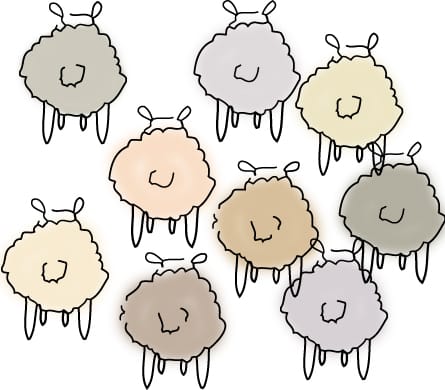The whole idea that color speaks is fascinating, don’t you think? I’ve been intrigued by color’s power to communicate for more years than I care to admit. A prime example would be the Colorgraphically Speaking series I started about a year ago.
Equally intriguing is how people choose to speak to color. I try to read what other people write about color from the perspective of someone who knows nothing about it. Take the following for example:
Beige is nearly infinite in its subtlety. Which beige you choose can alter the entire mood of a room. It looks different depending on the architecture and kind of light.
Beige is also known as tan, buff, cream and even khaki. It varies from nearly brown to very pale cream. It can have warm yellow undertones or pink undertones or be nearly gray. “Greige” seems to be the “It” neutral at the moment.
I could go along with the color sheeple crowd and pretend that I know exactly what that says about beige. Truth is I’m not sure what that’s supposed to mean. This is only one example that I stumbled upon today so I’m not hyper-focusing or criticizing this one in particular. I could find a gajillion more just like it. Which leads me to, I can only imagine how confusing it must be for someone struggling to get traction understanding color.

The reason why ubiquitous color talk like the above quote is so confusing is because descriptor words like beige, tan, khaki, greige, taupe are purely subjective. The reality is they’re throw-away words because everyone defines them differently. Many have unsuccessfully tried to align and define – once and for all – what those color names are supposed to mean.
Unsuccessfully.
Because of the following:
Poor color memory, eye fatigue, color blindness and viewing conditions can all affect the human eye’s ability to distinguish color differences. In addition to those limitations, the eye does not detect differences in hue (red, yellow, green, blue, etc.), chroma (saturation) or lightness equally. In fact, the average observer will see hue differences first, chroma differences second and lightness differences last. Source Xrite
Words like beige are moot. Instead, each color is categorized by hue and belongs to a hue family. It’s simple. Most importantly it’s concise. Color systems for ordering color are often misunderstood and underutilized.
And that’s something I’m passionate about changing.
Sheepie is not good, though the way you’ve colored the sheepies is lovely!
Sarah
http://interiorally.wordpress.com/